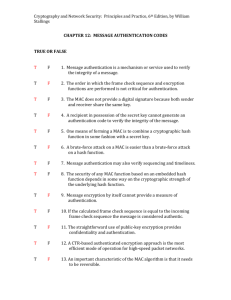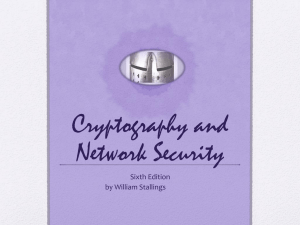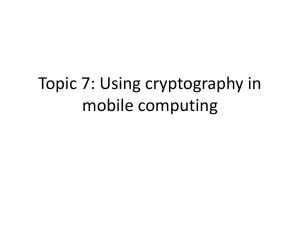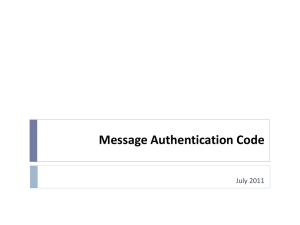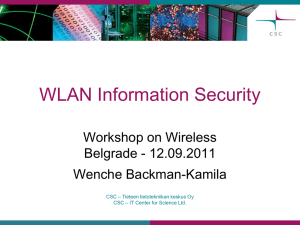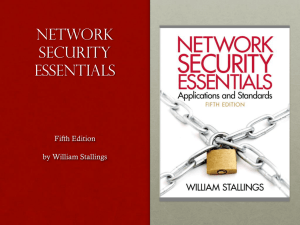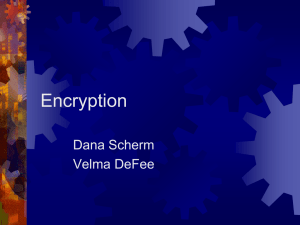Message Authentication Codes
advertisement
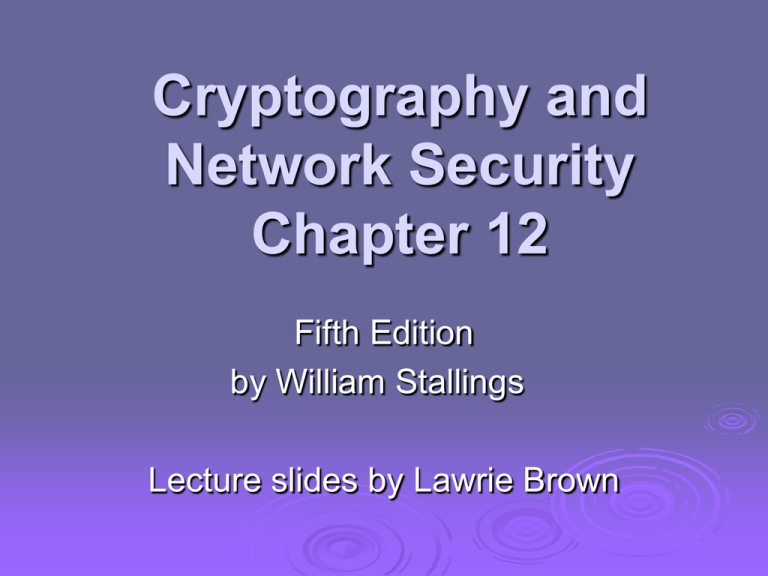
Cryptography and Network Security Chapter 12 Fifth Edition by William Stallings Lecture slides by Lawrie Brown Chapter 12 –Message Authentication Codes Each of the messages, like each one he had ever read of Stern's commands, began with a number and ended with a number or row of numbers. No efforts on the part of Mungo or any of his experts had been able to break Stern's code, nor was there any clue as to what the preliminary number and those ultimate numbers signified. —Talking to Strange Men, Ruth Rendell General Security Requirements (resistance against the following attacks) disclosure traffic analysis masquerade content modification sequence modification timing modification source repudiation destination repudiation Message Authentication Functions message authentication is concerned with: protecting the integrity of a message validating identity of originator non-repudiation of origin (dispute resolution) will consider the security requirements then three alternative functions used: hash function message encryption message authentication code (MAC) Message Encryption message encryption by itself also provides a measure of authentication if symmetric encryption is used then: receiver know sender must have created it since only sender and receiver know key used content can not be altered message has suitable structure, redundancy or a checksum to detect any changes Message Encryption if public-key encryption is used: encryption provides no confidence of sender since anyone potentially knows public-key however if • sender signs message using their private-key • then encrypts with recipients public key • have both secrecy and authentication again need to recognize corrupted messages but at cost of two public-key uses on message Message Authentication Code (MAC) generated by an algorithm that creates a small fixed-sized block depending on both message and some key like encryption though need not be reversible appended to message as a signature receiver performs same computation on message and checks it matches the MAC provides assurance that message is unaltered and comes from sender Message Authentication Code M – input message C – MAC function K – shared secret key MAC – message authentication code MAC = CK(M) Message Authentication Codes as shown the MAC provides authentication can also use encryption for secrecy why use a MAC? generally use separate keys for each can compute MAC either before or after encryption is generally regarded as better done before sometimes only authentication is needed sometimes need authentication to persist longer than the encryption (eg. archival use) note that a MAC is not a digital signature MAC Properties a MAC is a cryptographic checksum MAC = CK(M) is condenses a variable-length message M using a secret key K to a fixed-sized authenticator a many-to-one function potentially many messages have same MAC but finding these needs to be very difficult Requirements for MACs taking into account the types of attacks need the MAC to satisfy the following: 1. 2. 3. knowing a message and MAC, is infeasible to find another message with same MAC MACs should be uniformly distributed MAC should depend equally on all bits of the message Hash and MAC Algorithms Hash Functions condense arbitrary size message to fixed size by processing message in blocks through some compression function either custom or block cipher based Message Authentication Code (MAC) fixed sized authenticator for some message to provide authentication for message by using block cipher mode or hash function Keyed Hash Functions as MACs want a MAC based on a hash function because hash functions are generally faster code for crypto hash functions widely available hash includes a key along with message original proposal: KeyedHash = Hash(Key|Message) some weaknesses were found with this eventually led to development of HMAC HMAC specified as Internet standard RFC2104 uses hash function on the message: HMACK = Hash[(K+ XOR opad) || Hash[(K+ XOR ipad)||M)]] where K+ is the key padded out to size and opad, ipad are specified padding constants overhead is just 3 more hash calculations than the message needs alone any hash function can be used eg. MD5, SHA-1, RIPEMD-160, Whirlpool HMAC Overview HMAC Security proved security of HMAC relates to that of the underlying hash algorithm attacking HMAC requires either: brute force attack on key used birthday attack (but since keyed would need to observe a very large number of messages) choose hash function used based on speed verses security constraints Even broken hash functions (like MD5) can be used in HMAC. Using Symmetric Ciphers for MACs can use any block cipher chaining mode and use final block as a MAC Data Authentication Algorithm (DAA) is a widely used MAC based on DES-CBC using IV=0 and zero-pad of final block encrypt message using DES in CBC mode and send just the final block as the MAC • or the leftmost M bits (16≤M≤64) of final block but final MAC is now too small for security Data Authentication Algorithm CMAC previously saw the DAA (CBC-MAC) widely used in govt & industry but has message size limitation can overcome using 2 keys & padding thus forming the Cipher-based Message Authentication Code (CMAC) adopted by NIST SP800-38B CMAC Overview Authenticated Encryption: CCM and GCM Counter with Cipher Block Chaining-Message Authentication Code, abbreviated CCM, that can provide assurance of the confidentiality and authenticity of data. CCM is based on an approved symmetric key block cipher algorithm whose block size is 128 bits, such as the Advanced Encryption Standard (AES) CCM cannot be used with the Triple Data Encryption Algorithm (3DES) CCM is intended for use in a packet environment, i.e., when all of the data is available in storage before CCM is applied; Authenticated Encryption: CCM and GCM CCM is not designed to support partial processing or stream processing. The input to CCM includes three elements: 1) data that will be both authenticated and encrypted, called the payload; 2) associated data, e.g., a header, that will be authenticated but not encrypted; and 3) a unique value, called a nonce, that is assigned to the payload and the associated data Authenticated Encryption: CCM and GCM CCM consists of two related processes: generation-encryption and decryption-verification, which combine two cryptographic primitives: counter mode encryption and cipher block chaining-based authentication. Only the forward cipher function of the block cipher algorithm is used within these primitives. CCM (generic description,, without details) CCM use and criticism In many standards of wireless networks such as IEEE 802.11 [22] (WiFi), IEEE 802.15.40 (Wireless Personal Area Network/ZigBee) CCM is not on-line, CCM disrupts word-alignment, CCM can’t preprocess static associated data, The main issue is that CCM is not on-line since the sender has to know the length of the message before the beginning of the encryption. GCM (Galois/Counter Mode) NIST SP 800-38D The two functions that comprise GCM: authenticated encryption and authenticated decryption. GCM requires one block cipher operation and one 128-bit multiplication in GF(2128) per each block (128 bit) of encrypted and authenticated data. Intel in the newest CPUs has added the PCLMULQDQ instruction, highlighting its use for GCM GCM (Galois/Counter Mode) GHASHH(X1 || X2 || … ||Xm) = Ym Multiplication in a field GF(2128) with a block H. GCM (Galois/Counter Mode) Counter mode GCM (Galois/Counter Mode) Counter mode GHASH GCM (Galois/Counter Mode) GCM mode is used in IEEE 802.1AE (MACsec) Ethernet security, ANSI (INCITS) Fibre Channel Security Protocols (FC-SP), IEEE P1619.1 tape storage, IETF IPsec standards, SSH and TLS/SSL AES-GCM is included into the NSA Suite B Cryptography Summary have considered: MAC HMAC authentication using hash function CMAC authentication using a block cipher CCM GCM
